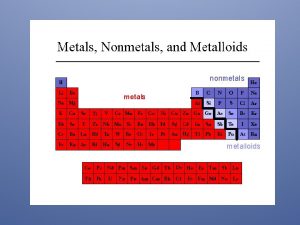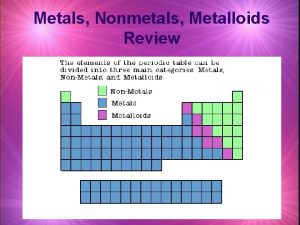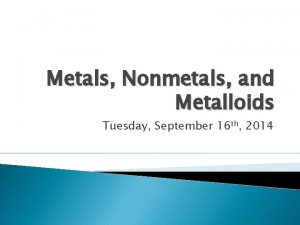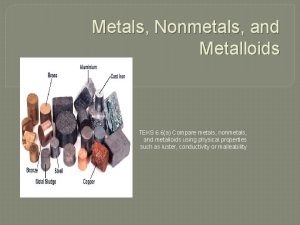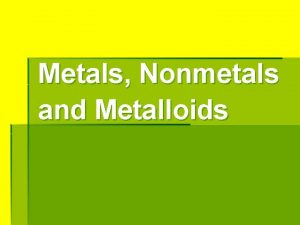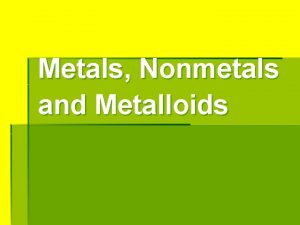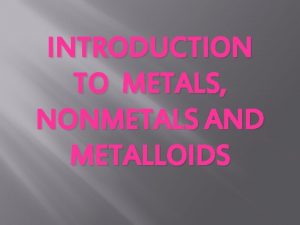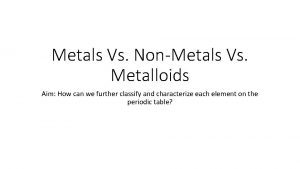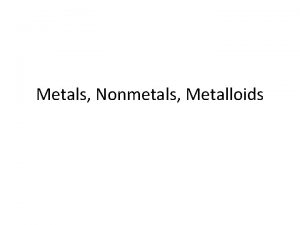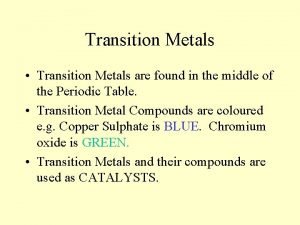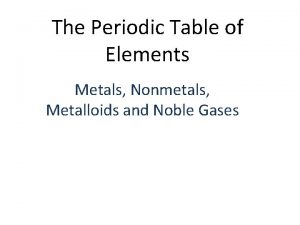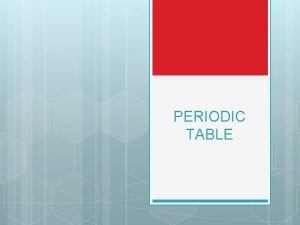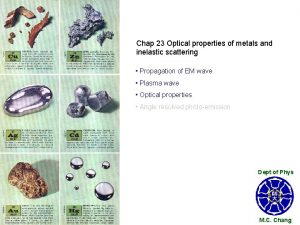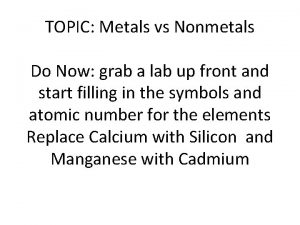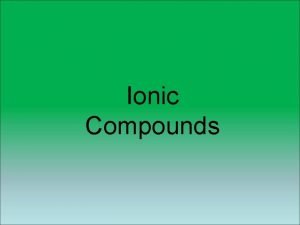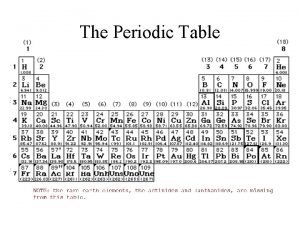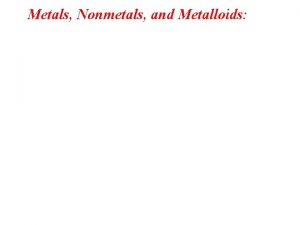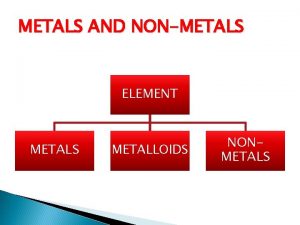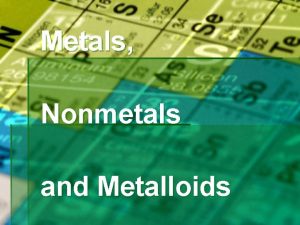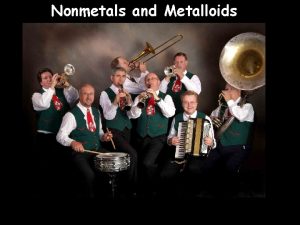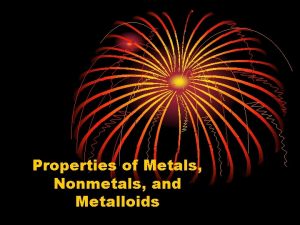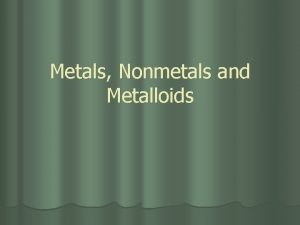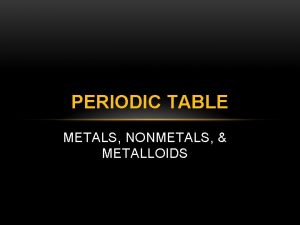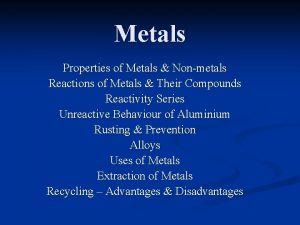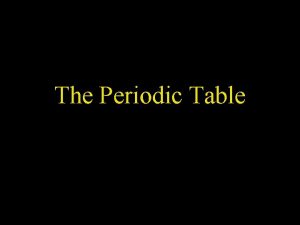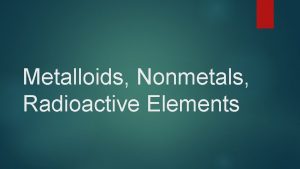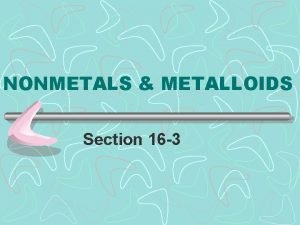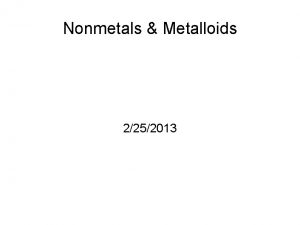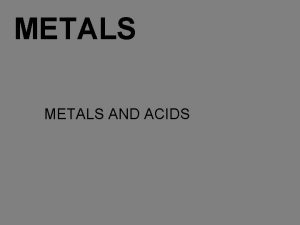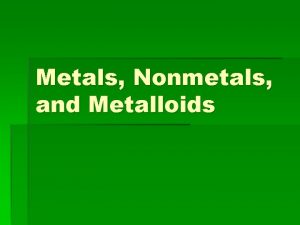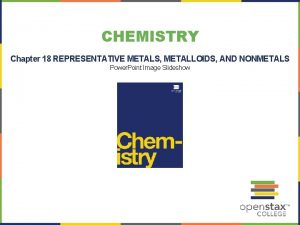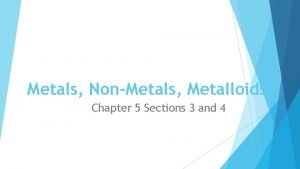Properties of Metal Nonmetals and Metalloids Metals versus




















- Slides: 20

Properties of Metal, Nonmetals, and Metalloids

Metals versus Nonmetals Differences between metals and nonmetals tend to revolve around these properties.

Metals versus Nonmetals • Metals tend to form cations. • Nonmetals tend to form anions.

Metals tend to be lustrous, malleable, ductile, and good conductors of heat and electricity.

Metals • Compounds formed between metals and nonmetals tend to be ionic. • Metal oxides tend to be basic.

Nonmetals • Nonmetals are dull, brittle substances that are poor conductors of heat and electricity. • They tend to gain electrons in reactions with metals to acquire a noble-gas configuration.

Nonmetals • Substances containing only nonmetals are molecular compounds. • Most nonmetal oxides are acidic.

Metalloids • Metalloids have some characteristics of metals and some of nonmetals. • For instance, silicon looks shiny, but is brittle and a fairly poor conductor.

Group Trends

Alkali Metals • Alkali metals are soft, metallic solids. • The name comes from the Arabic word for ashes.

Alkali Metals • They are found only in compounds in nature, not in their elemental forms. • They have low densities and melting points. • They also have low ionization energies.

Alkali Metals Their reactions with water are famously exothermic.

Alkali Metals • Alkali metals (except Li) react with oxygen to form peroxides. • K, Rb, and Cs also form superoxides: K + O 2 KO 2 • They produce bright colors when placed in a flame.

Alkaline Earth Metals • Alkaline earth metals have higher densities and melting points than alkali metals. • Their ionization energies are low, but not as low as those of alkali metals.

Alkaline Earth Metals • Beryllium does not react with water, and magnesium reacts only with steam, but the other alkaline earth metals react readily with water. • Reactivity tends to increase as you go down the group.

Group 6 A • Oxygen, sulfur, and selenium are nonmetals. • Tellurium is a metalloid. • The radioactive polonium is a metal.

Sulfur • Sulfur is a weaker oxidizer than oxygen. • The most stable allotrope is S 8, a ringed molecule.

Group VIIA: Halogens • The halogens are prototypical nonmetals. • The name comes from the Greek words halos and gennao: “salt formers. ”

Group VIIA: Halogens • They have large, negative electron affinities. – Therefore, they tend to oxidize other elements easily. • They react directly with metals to form metal halides. • Chlorine is added to water supplies to serve as a disinfectant.

Group VIIIA: Noble Gases • The noble gases have astronomical ionization energies. • Their electron affinities are positive. – Therefore, they are relatively unreactive. • They are found as monatomic gases.
 Metal vs non metal
Metal vs non metal Metals nonmetals and metalloids periodic table
Metals nonmetals and metalloids periodic table I am malleable, but i do not have a shiny luster.
I am malleable, but i do not have a shiny luster. Metals vs nonmetals periodic table
Metals vs nonmetals periodic table Non metals
Non metals Compare metals nonmetals and metalloids
Compare metals nonmetals and metalloids Difference between metals nonmetals and metalloids
Difference between metals nonmetals and metalloids Is boron shiny or dull
Is boron shiny or dull Metals nonmetals and semimetals
Metals nonmetals and semimetals Metal vs nonmetal
Metal vs nonmetal Periodic table divided in metals nonmetals and metalloids
Periodic table divided in metals nonmetals and metalloids Poem about metals nonmetals and metalloids
Poem about metals nonmetals and metalloids Periodic table metals nonmetals metalloids noble gases
Periodic table metals nonmetals metalloids noble gases Periodic table metals nonmetals metalloids
Periodic table metals nonmetals metalloids Non metals melting and boiling points
Non metals melting and boiling points Optical properties of metals and nonmetals
Optical properties of metals and nonmetals Metals vs nonmetals
Metals vs nonmetals Non metals examples
Non metals examples Periodic metals and nonmetals
Periodic metals and nonmetals Periodic table separating metals and nonmetals
Periodic table separating metals and nonmetals Non metals uses
Non metals uses


